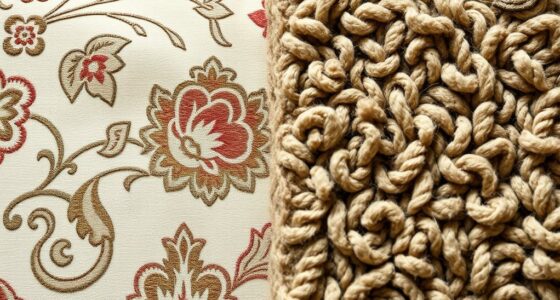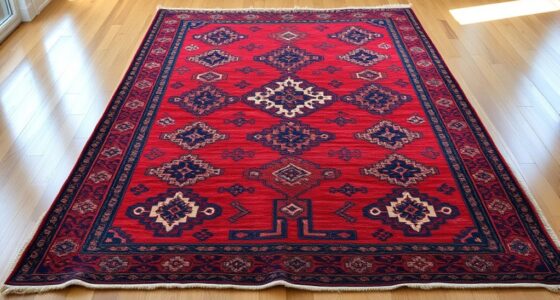When silk pile is aligned in a specific direction, light interacts differently, causing color shifts and enhanced sheen. By observing how surface reflections and refraction change with angle, you can identify pile orientation—fibers reflect light more vividly or subtly depending on their alignment. Variations in dye absorption and surface texture also play a role in these visual effects. If you explore further, you’ll discover how to use light to reveal silk’s dynamic color shifts and intricate details.
Key Takeaways
- Silk’s fiber arrangement causes light reflection and refraction, leading to color shifts based on viewing angles.
- Pile direction influences how light interacts with fibers, creating iridescence and changing perceived hues.
- Surface sheen and fiber orientation affect color perception, with different angles revealing varying hues and depth.
- Lighting conditions, such as angle and intensity, significantly alter how silk’s colors appear and shift.
- Dye absorption and fiber transparency modify refraction, resulting in dynamic color effects when light interacts with the surface.
Understanding the Structure of Silk Pile
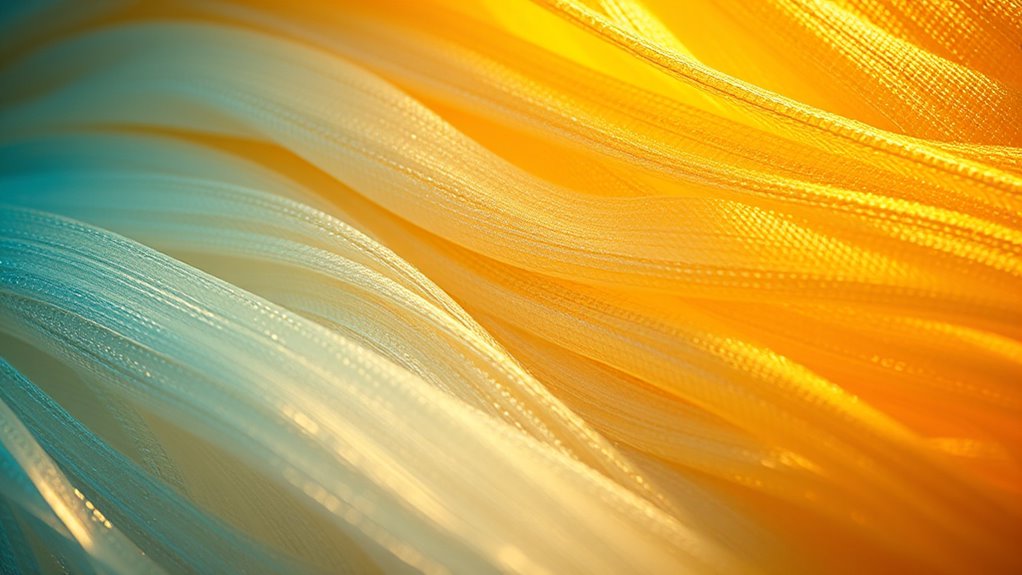
To understand the structure of silk pile, it’s essential to recognize how the fibers are arranged and woven. The fiber arrangement determines the overall appearance and how light interacts with the surface. In silk pile, fibers are looped or cut to create a plush, textured surface, with pile density referring to how tightly packed these fibers are. A higher pile density means more fibers per square inch, resulting in a richer, more luxurious feel and subtle light reflection. Conversely, a lower pile density produces a more open, airy texture. This arrangement influences not only the tactile quality but also the visual effects, such as color shifts and shimmer. Understanding the fiber arrangement and pile density is crucial for appreciating how silk pile can exhibit color perception changes under different lighting conditions. By understanding fiber arrangement and pile density, you gain insight into silk pile’s unique ability to reflect and refract light.
The Science of Light Reflection and Refraction on Silk

When light hits silk, it reflects and refracts in ways that create stunning visual effects. You’ll notice color shifts as you change your viewing angle, revealing the fabric’s shimmering qualities. Understanding these optical principles helps you appreciate how silk’s surface interacts with light to produce its unique luster. The light reflection and refraction processes are influenced by the silk’s smooth surface and its ability to bend light, enhancing its visual appeal.
Light’S Interaction With Silk
Light interacts with silk in fascinating ways because its smooth, shiny surface reflects and refracts rays differently depending on the angle and quality of the light. The fiber composition of silk, primarily protein-based, creates a natural luster that influences how light bounces off its surface. This surface smoothness allows for high reflectivity, giving silk its characteristic sheen. Additionally, dye penetration plays a vital role; well-absorbed dyes fill the fiber’s microscopic structures, affecting how light interacts with the fabric. Light may be reflected, refracted, or absorbed, depending on these factors. Variations in fiber orientation and dye depth alter the silk’s appearance, making it shimmer or change hue as the viewing angle shifts. Understanding these interactions helps explain silk’s unique optical qualities. Moreover, light reflection and refraction are influenced by the silk’s surface smoothness and fiber arrangement, which can be studied to enhance textile design.
Color Shifts With Angles
As you observe silk from different angles, you’ll notice its colors often shift and shimmer, a phenomenon rooted in the science of light reflection and refraction. This effect occurs because the fiber arrangement influences how light interacts with the surface, causing certain wavelengths to reflect more prominently at specific angles. Additionally, dye absorption varies along the fibers, impacting how colors appear depending on your viewpoint. When light hits the silk, the way it’s reflected depends on the surface’s microscopic structure, producing dynamic color shifts. This interplay is a prime example of light reflection and refraction in action, demonstrating how microscopic patterns can influence visual perception. To illustrate, consider the following:
| Fiber Arrangement | Color Perception at Different Angles |
|---|---|
| Parallel fibers | Bright, vivid hues visible directly |
| Crossed fibers | Subtle, iridescent shifts observed |
| Dense packing | Increased color depth and shimmer |
| Loose arrangement | Softer, more muted color effects |
| Irregular pattern | Unpredictable, shimmering changes |
Refraction and Reflection Effects
Have you ever noticed how silk seems to glow or shimmer differently depending on the angle you view it? That’s due to refraction and reflection effects influenced by its fiber composition. Silk’s smooth, tightly woven fibers cause light to bend and bounce in unique ways, creating shimmering visual effects. The way light refracts depends on the fiber’s structure and transparency, altering how you perceive color and sheen. Additionally, reflection plays a role; light hitting the surface can bounce back, enhancing the silk’s luster. Dye absorption also impacts these effects—dyes penetrate the fibers differently based on their chemical makeup, affecting how light interacts with the surface. Together, fiber composition, dye absorption, and light behavior shape the mesmerizing visual qualities of silk. Furthermore, the light behavior is affected by the silk’s surface texture, which influences how light is scattered and reflected.
How Pile Direction Affects Color Perception
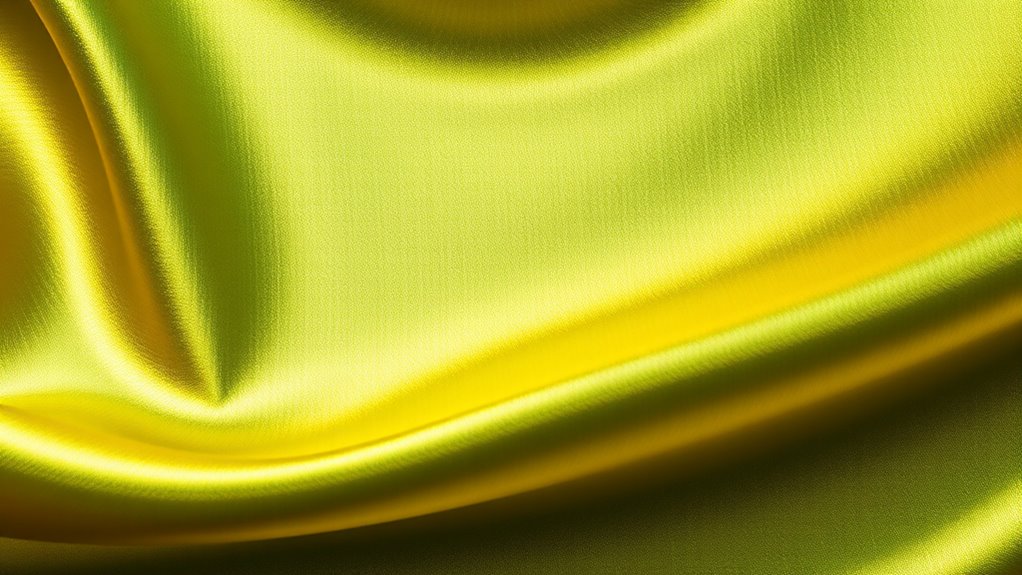
The direction of silk pile can profoundly influence how colors appear to the eye. When you change the pile’s orientation, the fiber sheen shifts, altering the way light reflects off the surface. This affects your perception of color intensity and hue. Pile direction also impacts dye absorption; fibers brushed in one direction may absorb dye differently than those brushed against it, resulting in subtle color variations. For example, when viewing silk from different angles, the same fabric can look richer or duller depending on pile orientation. Recognizing these effects helps you select silk with the desired visual qualities. By understanding how fiber sheen and dye absorption interact with pile direction, you can better predict how colors will look under various lighting and viewing conditions. Additionally, growth conditions like light exposure can influence fiber quality, further affecting color perception.
Visual Effects Created by Light and Silk Interaction
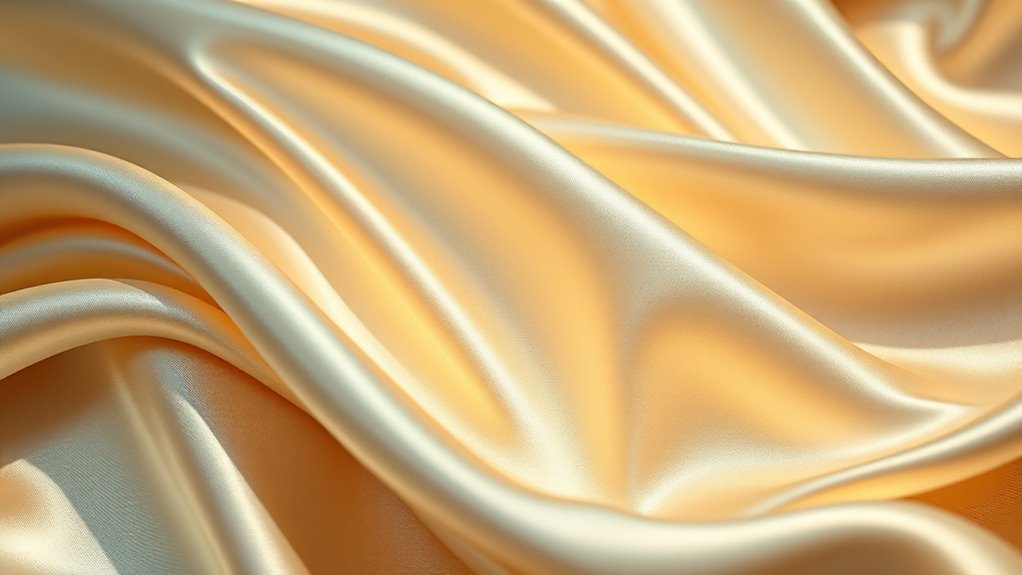
Light interacting with silk fibers creates a mesmerizing array of visual effects that can dramatically enhance or subtly alter the fabric’s appearance. The way light reflects and refracts depends on fiber composition and dye penetration, influencing color shifts and sheen. Silk’s smooth surface and fiber structure produce dynamic visual effects, such as iridescence or depth variations, depending on how light hits the fabric. When dye penetrates unevenly, it accentuates certain areas, creating a play of light and shadow. To illustrate, consider the following effects:
| Effect | Cause | Result |
|---|---|---|
| Iridescence | Light refraction in fibers | Shifting colors in view |
| Depth enhancement | Dye penetration variability | Rich, layered appearance |
| Sheen | Fiber surface smoothness | Lustrous, glowing look |
| Color shifts | Pile direction interaction | Changing hues with movement |
| Visual texture | Fiber composition and light | Enhanced fabric dimension |
Additionally, the fiber structure plays a crucial role in how these effects are perceived, influencing the overall visual experience.
Techniques for Identifying Silk Pile Orientation

You can identify silk pile orientation by observing visual texture cues, such as how the surface feels or appears when touched or viewed from different angles. Light reflection patterns also reveal the direction, as the pile tends to reflect light differently depending on its orientation. Paying attention to these signs helps you accurately determine the silk’s pile direction with confidence. Additionally, understanding the color accuracy of the material can aid in recognizing subtle shifts in hue caused by pile orientation.
Visual Texture Cues
Visual texture cues are essential tools for identifying the direction of silk pile, especially when examining the surface closely. You can observe subtle differences in the fiber weave, which influence how the silk catches light and feels to the touch. The way dye absorption varies along the fibers also reveals pile orientation, as dye may settle unevenly depending on pile direction. By scrutinizing surface irregularities, you can detect the flow of the fibers and their alignment. Additionally, understanding personal finance management principles can help you make informed decisions about investing in quality textiles or restoration projects to preserve their appearance and value.
- Look for subtle changes in surface sheen
- Notice uneven dye absorption patterns
- Feel for differences in texture and smoothness
- Observe how light interacts with the fiber weave
- Detect variations in tension along the pile
Light Reflection Patterns
By carefully observing how silk surfaces reflect light, you can determine the direction of the pile with greater accuracy. Light reflection patterns reveal subtle differences based on fiber composition and manufacturing techniques. Silk fibers woven with the pile facing a certain way reflect light differently than when reversed, creating distinct sheen or matte areas. Smooth, tightly woven fabrics tend to produce consistent reflection patterns, while looser weaves or variations in fiber thickness cause irregularities. Understanding these patterns helps you identify the silk’s pile orientation more reliably. Recognizing how manufacturing techniques influence light behavior allows you to distinguish natural fiber movement from artificial alterations. Additionally, the integration of AI in textile analysis is projected to redefine quality control, making it easier to assess fabric orientation with precision. Paying close attention to the way light plays on silk surfaces gives you a powerful tool for accurate pile direction assessment.
The Role of Lighting Conditions in Silk Appearance
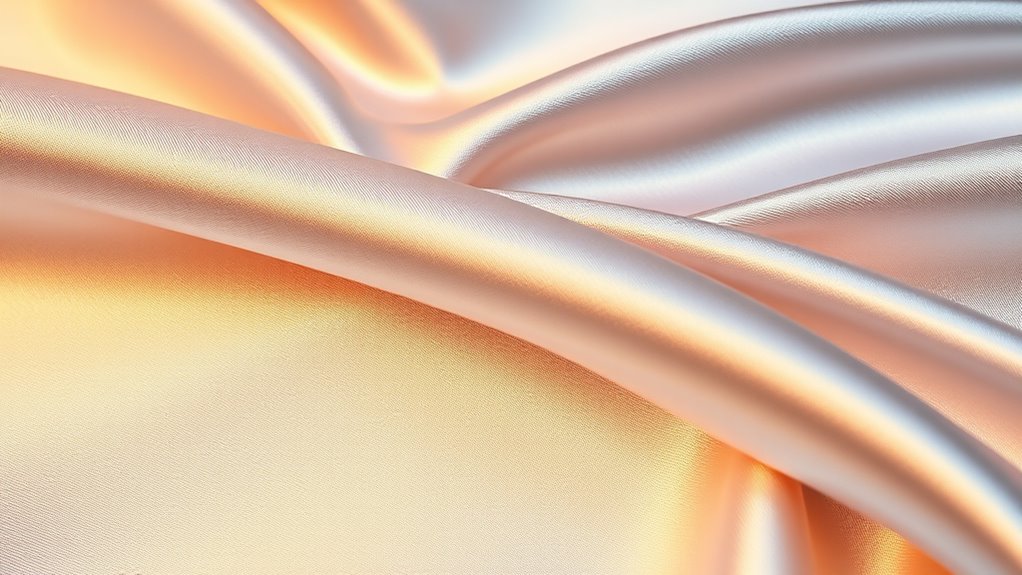
Lighting conditions play a crucial role in how silk’s pile direction and sheen are perceived. The way light hits silk can highlight subtle differences in fiber composition and dye penetration, altering its apparent color and texture. Bright, direct light often emphasizes sheen and depth, making the silk appear more vibrant, while softer lighting minimizes these effects. The angle and intensity of light influence how you see the silk’s surface, revealing or hiding the pile’s direction. Additionally, uneven lighting can create shadows that distort color perception. To truly appreciate silk’s qualities, observe it under various lighting conditions.
- Bright sunlight enhances sheen, revealing fiber details
- Warm indoor lighting softens color shifts
- Side lighting accentuates pile direction
- Overhead lighting minimizes surface reflections
- Low light emphasizes dye penetration variations
Practical Tips for Showcasing Silk Textiles

To effectively showcase silk textiles, you should pay close attention to how you position and light the fabric. Proper lighting highlights the silk’s fiber weaving, revealing its texture and luster. Experiment with angles to emphasize pile direction, which influences dye absorption and color shifts. Use soft, diffused light to minimize glare and enhance subtle color variations. When displaying silk, consider the weave pattern to show off its craftsmanship. Make sure the fabric is smooth and free of wrinkles for a clean presentation. Here’s a quick guide:
| Tip | Explanation |
|---|---|
| Use angled lighting | Enhances fiber weaving and color shifts |
| Highlight pile direction | Shows how light interacts with the silk surface |
| Adjust for dye absorption | Reveals true color and texture |
These tips ensure your silk textiles look their best.
Common Mistakes When Viewing or Displaying Silk

When displaying silk textiles, mistakes often stem from overlooking the fabric’s delicate nature and unique characteristics. For example, ignoring the fiber weave can cause uneven draping and misinterpretation of color shifts. Poor handling may crush the pile or distort the dye absorption, leading to inaccurate color perception. Additionally, exposing silk to direct sunlight can fade colors and damage the fibers. Misaligning the pile direction can also distort how light interacts with the fabric. In conclusion, using harsh lighting or improper backgrounds can exaggerate or mask subtle color variations. To avoid these errors, handle silk gently, display it in controlled lighting, and pay attention to the fiber weave and dye absorption. Proper care ensures you appreciate silk’s true beauty without compromising its structure or color fidelity.
Comparing Satin, Velvet, and Other Pile Fabrics
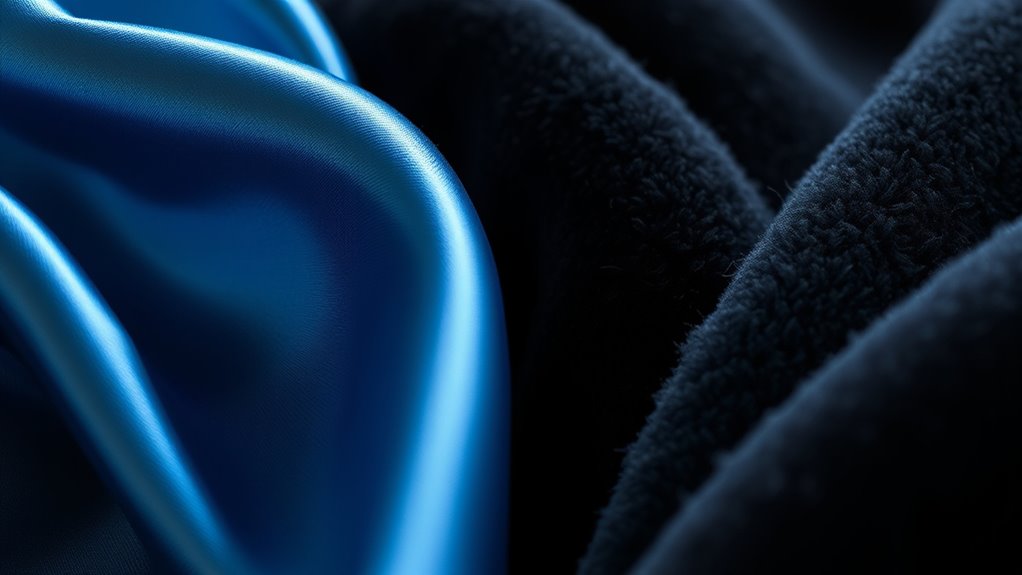
Comparing satin, velvet, and other pile fabrics reveals distinct differences in texture, appearance, and how they reflect light. Satin features a smooth, tightly woven fiber arrangement that creates a glossy surface, enhancing dye penetration and leading to vibrant, uniform colors. Velvet, on the other hand, has fibers arranged in a dense, looped pile, giving it a plush texture and a matte finish, which affects how light interacts with the surface. Other pile fabrics, like velour or plush, vary in fiber density and arrangement, influencing their reflectivity. The fiber structure determines not only the tactile feel but also how light shifts across the surface, affecting color perception. Understanding these differences helps you choose fabrics that best highlight silk’s color-shifting qualities.
Innovative Ways to Highlight Silk’s Color Shifts

The unique light-reflecting properties of different pile fabrics influence how silk’s color shifts come across. To highlight these changes, focus on techniques that enhance fiber strength and dye penetration, making color variations more vivid. Experiment with adjustable lighting to emphasize subtle shifts or use directional light to play with reflections. Incorporate contrasting background colors to accentuate the silk’s luster. Applying controlled tension during weaving can reveal how pile direction affects color perception. Additionally, selecting dyes with deep penetration ensures color shifts are more noticeable across the fabric’s surface.
- Use angled lighting to enhance color play
- Choose dyes with high dye penetration for vivid shifts
- Adjust pile tension to emphasize direction effects
- Pair silk with contrasting backgrounds
- Incorporate fiber treatments to boost fiber strength
Frequently Asked Questions
How Does Ambient Temperature Influence Silk’S Color Perception?
Ambient temperature influences how you perceive silk’s color through thermal effects and temperature fluctuations. As temperature rises or drops, silk’s fibers expand or contract slightly, altering how light interacts with the surface. These thermal effects can cause subtle color shifts, making the silk appear different in various environments. So, when you notice color changes, consider how temperature fluctuations might be impacting your perception, rather than just the lighting conditions.
Can Silk Pile Direction Change Over Time With Wear?
Over time, silk pile direction can change due to fiber aging and wear. As fibers weaken and fibers shift with foot traffic or cleaning, the pile alignment may alter, affecting the fabric’s appearance. You might notice the silk’s original direction becomes less consistent, leading to color variations or a worn look. Regular care and gentle cleaning help maintain the pile’s alignment and slow down these changes.
What Role Do Dyes Play in Silk Color Shifts Under Light?
Think of dyes like tiny artists painting silk. In natural dyeing, dyes are more sensitive to light, like a delicate watercolor. Exposure causes chemical reactions that can alter the original colors, making them shift or fade over time. This is especially true with natural dyes, which react differently under light compared to synthetic ones. So, the dyes you choose directly influence how your silk’s color changes as it’s exposed to light.
How Do Different Lighting Angles Impact Silk’S Visual Texture?
You’ll notice that lighting angles considerably impact silk’s visual texture. When light hits at different angles, it highlights or shadows the fibers, creating a sense of depth and dimension. This variation can make the silk appear more lustrous or matte, depending on how the light interacts with its surface. By changing your viewing angle or adjusting the light source, you can enhance or soften the silk’s visual texture to suit your preference.
Are There Specific Silk Types More Prone to Color Variation?
Think of silk like a chameleon—some types change color more than others. You’ll find that silk with delicate fiber characteristics, such as raw or untreated silk, tends to show greater color variation. These fibers often have less dye stability, making their hues shift with light. So, if you want consistent color, opt for treated or processed silk, which maintains its dye stability and resists color changes better.
Conclusion
When you master the secrets of silk pile direction, you reveal a world where colors dance and shift like magic, transforming your view into a mesmerizing spectacle. With just a simple change in how you look or display silk, you’ll see colors flicker and shimmer like a thousand sunsets, making every piece feel alive and enchanted. Get ready to turn your appreciation into an awe-inspiring experience that’ll leave everyone utterly captivated!




